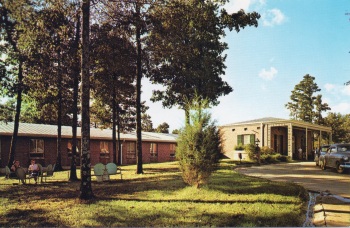Rural and small-town hospitals have been in the news lately, and it reminded me of this article from 1948, a period of great optimism in public health when Mississippi’s network of public hospitals was the talk of the nation.
Mississippi Leads Nation in Building New Hospitals
Already a nationally recognized leader in the field of public health, Mississippi has just scored another record in its humanitarian program to thwart killing disease and provide adequate medical attention for its predominately rural citizens.
During the first year of a 5-year hospital building program, for which federal funds are available to all states, Mississippi has led the nation in the number of projects it has secured, with 28 installations, or about 30 per cent of all those approved in the nation to date. A total of 17 hospitals and 11 health centers, approved under the program, will give Mississippi 639 of the 5,500 new hospital beds needed.
Next year’s program calls for construction of 30 hospitals and health centers, of which 24 have already been locally approved. An addition of 1074 beds will thus be provided.
Back in 1946, the Mississippi Legislature appropriated $5,000,000, the first large state appropriation in the Nation, as its part in footing the bill for a needed 5,500 hospital beds in the state. At the same time it created the Mississippi Commission On Hospital Care to administer a state-wide plan for construction and equipment of hospitals, nurses’ homes, health centers, clinics and related facilities as provided for under the Hill-Burton Bill passed by Congress.
Under this bill, known as piblic law 735, a total of $375,000,000 was appropriated as federal aid for use by state and local agencies for hospitals during a 5-year period. Mississippi will receive $2,400,000 per year, or a total of $12,000,000 for such hospitals for the 5-year period covered by the appropriation.
SURVEY SHOWS NEED
The first job of the newly formed Commission was the conducting of a survey to determine Mississippi’s hospital needs.
It was found that the state has only 114 hospitals with 4,200 beds of which about two-thirds were for whites and one third for negroes. The Commission found through the survey that Mississippi needed better than 5,500 new beds to provide the needed facilities for the state’s two million people.
In 24 counties where there were no hospital facilities priority was given to take care of these areas first. Every hospital secured under the program, to date, will be located in a county which has no such facilities.
Significant too, is the fact that every one of these is a public institution, indicating that state funds appropriated for this purpose are being used.
Contracts on the first two projects have already been let, and construction is now underway on the Clay County Health Center at West Point and the Winston County Health Center at Louisville, among the first underway in the nation. Bids on two or three additional hospitals are expected to be advertised in April.
Hospitals approved this year will be located at Carthage, Ripley, Ackerman, Hazlehurst, Belzoni, Meadville, Ellisville, Macon, Ruleville, Lucedale, Leakesville, DeKalb, Forest, Booneville, Columbia, Okolona and Starkville. Public health centers will be located at Kosciusko, Cleveland, Meadville, Rolling Fork, Brandon, Greenville, Purvis, Vaiden and Carrollton.
IMPORTANT MILESTONE
Mississippi’s goal of 5,500 hospital beds within the next five years marks an important milestone in an already star-studded public health program which has witnessed near miraculous results in a constant fight against disease.
Because of the proximity to the Mississippi River, with her ever-changing backwaters, the state’s health problem has been acute since the first recollection of early pioneers. In 1870 a Yellow Fever epidemic nearly wiped out the population, and in that same year the first State Board of Health was established.
By 1900 progress was being made. Information on the deadly typhoid was perfected and hygiene and health control measures had been initiated. But even as late as 1916 typhoid killed 463 persons, a far different picture from the nine deaths in 1946.
The common diseases in Mississippi have been checked today, thanks to an excellent public health program. The Magnolia State has become a leader in this respect in the face of adverse conditions.
Health in Mississippi has always been more or less dependent on state aid because of economic difficulties and limited local revenue. An outstanding factor in the program of public health in the state has been the enabling laws of the Legislature, which completely removed the health department from politics and encouraged establishment of a merit system.
LEGISLATURE SUPPORTS HEALTH
The law-making body supported the health of Mississippians with incredible appropriations for such things as county control of venereal disease, a major state problem. It also has passed regulations restraining the harmful pollution of waters. When the need for physicians in rural areas became apparent, the Legislature authorized grants to assist medical students through loans, provided they would return and practice in Mississippi for a given period. Today 34 students are attending 15 medical schools under this plan. These young doctors, the Board of Health believes, will render many years of useful service and will practice in smaller communities where the need is greatest.
As a result of Mississippi’s attention to the health of her people, death from disease common to the area has been sharply reduced. Our death rate in 1946, for instance, was only 8.2 per thousand, compared with a national average of 10.6.
In 1915, for instance, 1942 persons died of malaria, compared with only 29 in 1946. Pellagra killed 1535 in 1915, only 46 in 1946. Diptheria claimed 364 in 1921, only 31 in 1946. Even tuberculosis, one of the state’s greatest problems, is being curbed–3793 deaths in 1915, 694 in 1946. Other diseases have been reduced comparably.
“Although the medical, public health and hospital needs of the state are still very great,” according to Dr. D.V. Galloway, executive officer for the hospital commission, “it appears that the people the the legislature have found the proper answers, and upon completion of the medical and hospital program now underway, every citizen of the state will have adequate health, medical and hospital care.
“Mississippi’s new industrial program is also important,” Dr. Galloway points out, “in that it is assisting in stabilizing Mississippi’s income so that voluntary hospital insurance is becoming an important factor in the maintenance and support of hospitals.”
Bolivar County News-Enterprise, June 16, 1948
Categories: Architectural Research, Hospitals/Medical, Houston, Ripley, West Point



We recently digitized a broadside printing of this article, though it’s not yet linked to its catalog record: http://zed.mdah.state.ms.us:81/cgi-bin/koha/opac-detail.pl?biblionumber=118854
LikeLike
2.5 years later, it is now linked: http://www.mdah.ms.gov/arrec/digital_archives/series/broadsides/detail/118854-broadside-01.tif
I always forget that I must remove that :81 from links to our catalog records; here is the correct link if it matters now:
LikeLike
As I increasingly say with forced cheerfulness the more my own office gets backlogged: “Better late than never!”
LikeLike
Thank you to whomever changed my name! I think this post is cursed for me.
LikeLike
Wanting to seek info from my mother’s hospital stay in Ripley in 1946 when I was born. She had an extended stay due to an explosion in Middleton TN. of the family home. She gave birth to me after weeks in hospital recovering from “flash burns” from explosion. Always wanted to know more details about her stay & recovery. She never talked about it much but told me the doctors thought she would deliver prematurely due to trauma. She went home a few days before my birth & returned to give birth 4/20/1946.
Would appreciate any info go researching further.
LikeLike
As with so many things concerning architecture in Mississippi, N. W. Overstreet was at the forefront.
Overstreet’s Nomination for Advancement to a Fellowship in the AIA, from March 29, 1949, states, “Mr. Overstreet designed and built the first hospital in Mississippi under the Hill-Burton Act, 1947, which was the Northeast Mississippi Hospital at Booneville, Mississippi. This hospital was one of the first three in the country under this Act. He is a member of the Advisory Council to the Mississippi Commission On Hospital Care.”
LikeLike